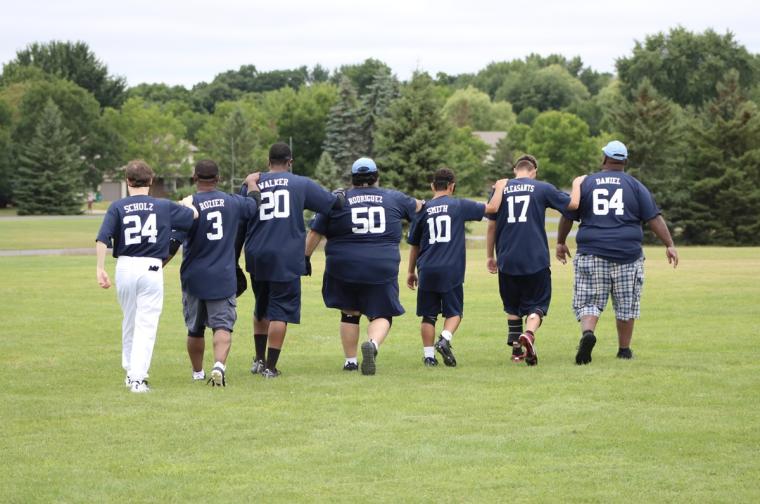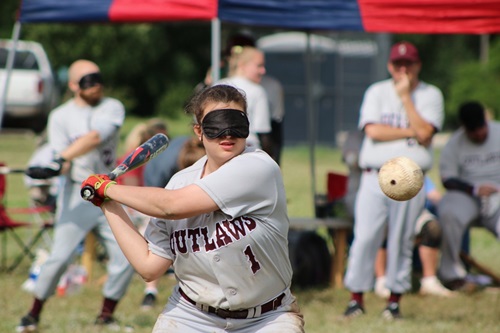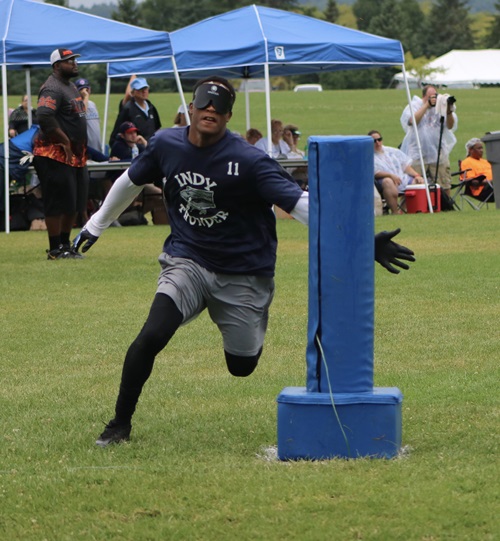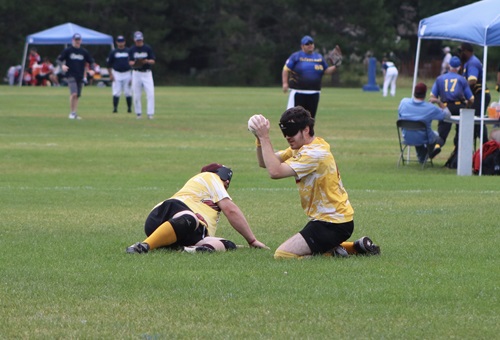
All photos courtesy of the website of the National Beep Baseball Association
The Paralympics start on August 28 and while beep baseball, a sport for the blind and those with visual impairments, isn’t contested there, it’s great to know about the sports that exist for special populations. And it’s a great time to review the nearly 50-year-old organization that teaches athletes what they can do – not what they can’t do.
Baseball has long been known as a sport that employs good hand/eye reflexes, as well as speed and strategy. But the athletes of the National Beep Baseball Association (NBBA), who are visually impaired or blind, push most of those skills to the next level.
Beep baseball is played with two bases (equivalent to first and third) and a noise-emitting, oversized softball. The bases are blue, nearly 5 ft (1.5 m) tall, and have mostly foam interiors with electronics that cause them to buzz steadily to allow players to locate them. (More information is available at this link on the NBBA website.)
According to the NBBA’s website, “There are two conventional ways to enjoy baseball: As a fan or as a player. Only a small percentage of players actually make it into the major leagues. But thousands of people, at varying degrees of success and levels, joyously charge out to their positions on fields and sandlots to the cry of “play ball.”
Not long ago, that privilege was not an option for persons who lacked sufficient vision to play the game. But NBBA changed all that starting in the mid-1970s. The organization’s president, Jerry Windell, sat down with SDM to discuss NBBA, its events, its goals and, of course, the population it serves.
 Sports Destination Management: You have a background in sports for those with visual impairments.
Sports Destination Management: You have a background in sports for those with visual impairments.
Jerry Windell: I actually participated in the Paralympics and retired from goalball in 1990. I started playing beep baseball in 1992.
SDM: What is the footprint of beep baseball?
Windell: We’re a relatively niche organization. Our outreach is that of a small group; we’re not something that is going to make anybody a whole lot of money.
SDM: But it is a great event as far as being inspirational to others. What are the demographics like?
Windell: This is very much a family event. We have people playing from teenagers up to their sixties. Our teams aren’t broken down into gender or age groups, and there are no competitive categories for skill level. We do seed all our teams and divide them up into pools. Every tournament is played in double-elimination format, so that everyone finishes up in a specific place, whether that’s first place or 20th place.
SDM: What kind of facilities do you need?
Windell: A beep baseball field is smaller than a regulation baseball field for either high school, college or the majors. We predominantly play on fields that are about the size of an adult soccer field – about 210 to 220 feet in all directions. We need a field with a distance our defensive players can throw.
 SDM: Are the rules different as well?
SDM: Are the rules different as well?
Windell: The game is played by those who are either visually impaired or blind. Everyone plays blindfolded to make sure play stays fair. We do depend on sighted people to help us out; we’ll have spotters in the outfield and we use sighted pitchers and catchers as well. There are six innings as opposed to nine, and four strikes rather than three. Teams can elect to use a designated hitter or designated fielder if they want.
Fun Fact: Jerry Windell is legally blind and has pitched his World Series team to a win.
SDM: NBBA represents a chance to play with others who are challenged. We are seeing that unified sports, in which athletes both with and without challenges, play together, are on the increase.
Windell: Yes, more and more these days, people with visual impairments are mainstreamed. I went to the Indiana School for the Blind, and if you were there, chances were you were going to take part in athletic programs of some kind with people who were also visually impaired or blind.
SDM: There is also stronger advocacy for those with challenges, and consequently, a lot more programming than perhaps there used to be.
Windell: Yes, Today, there are easy ways to communicate and many more tools to use to pass along information on sports that are available, whether those are beep baseball, goalball, soccer for the blind or anything else.
SDM: Returning to NBBA. You put on a World Series as well as regional events. What kind of an overview does NBBA have for potential host cities?
Windell: Overall, we look for a host city that has a host site, meaning a soccer complex, with a minimum of 12 fields. We also need hotel space, since we will have at least 500 people who will attend; NBBA uses upwards of 160 rooms. There is also a need for meeting and banquet facilities. Something that is very important to us is transportation from the hotel to the competition venue, so it is best if everything can be in one location. We’ll be carrying on the business of the organization at the same time so if we can have places to meet, that is also helpful.
SDM: For the World Series, how many teams participate?
Windell: I’d say that 20 is a good number of teams. With that number of teams, the maximum number of games you’ll have going on any time is 10.
 SDM: What about spectators?
SDM: What about spectators?
Windell: A lot of people make it a family type of vacation. A typical team might have six players but some can have 10 to 12, and there are a few with upwards of 30 to 40 people.
SDM: Where are the World Series being held in the next few years?
Windell: The 2024 World Series will be held July 21-27 in St. Charles, Missouri. We are partnering with MindsEye and the Lighthouse for the Blind – St. Louis. Our website has a calendar of our events.
SDM: Who should people contact if a destination is interested in hosting?
Windell: They can e-mail president@nbba.org or jwindell@nbba.org.

